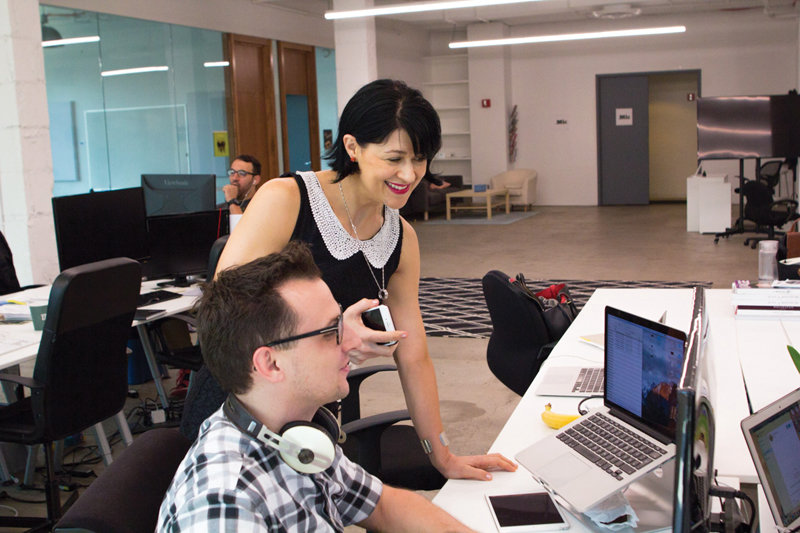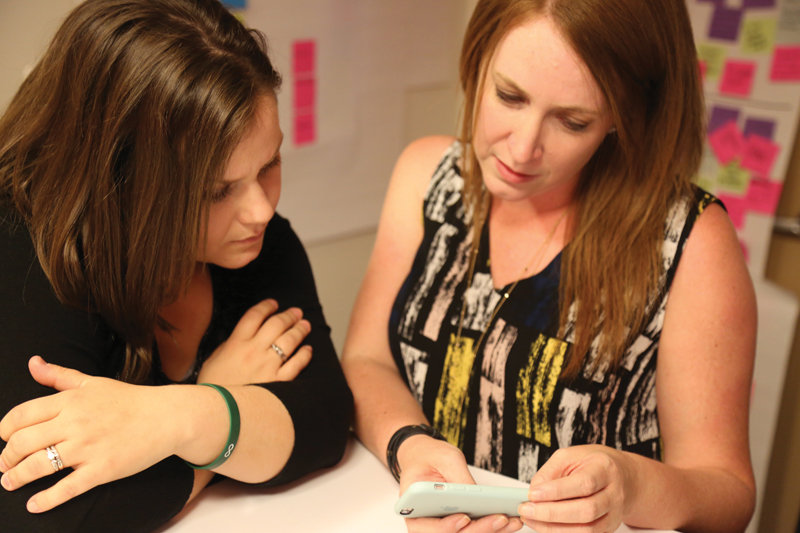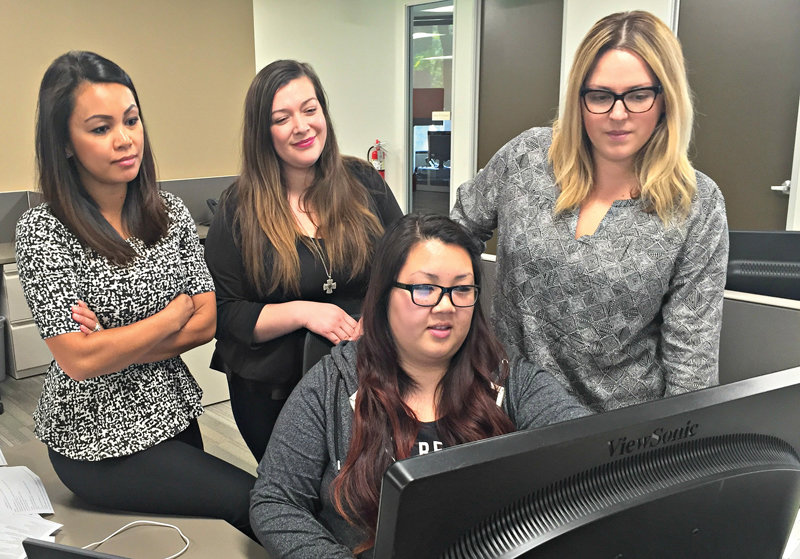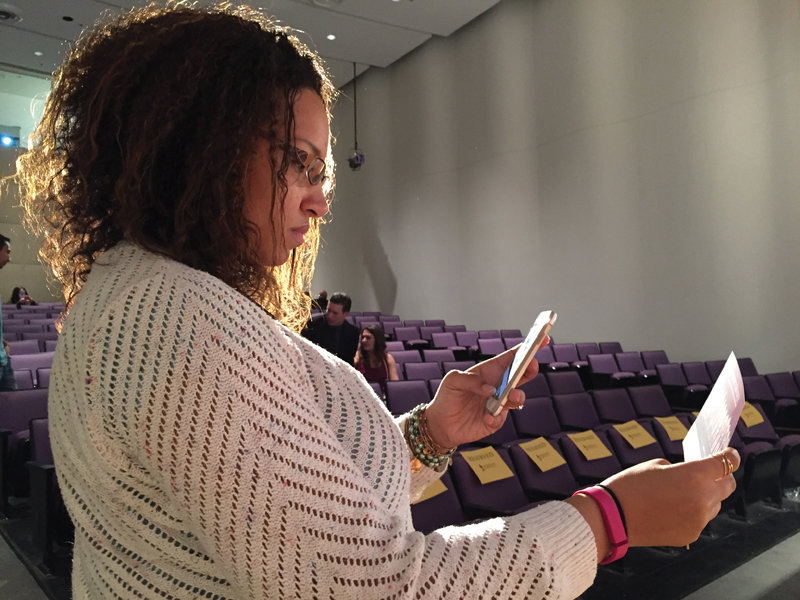Today’s newsroom leaders are often pulled in endless directions: Should we use Snapchat or Facebook Live for this press conference? How do we apply 360-degree video to that story? When should we livetweet and engage with our audiences? Their to do lists are endlessly growing.
The challenges can seem daunting, but these leaders aren’t afraid of the seismic shift the digital age has brought on. Their objective is to experiment and build strategies for some of the industry’s latest digital offerings. While some digital leaders admit they didn’t expect to be working in the position they are today (virtual reality editor?), that’s the nature of the industry’s evolving landscape.
E&P spoke with some of these digital leaders who are embracing these changes. The women in these roles come from traditional and non-traditional backgrounds, but they all have a common goal: they want to see this industry succeed, and to do that, they must see digital succeed.
 Cory Haik inside the Mic office working with staff.
Cory Haik inside the Mic office working with staff.
Mic’s Digital Content Strategy
At Mic, the digital news outlet based in New York City and known for its millennial-focused content, it’s all about strategy. After spending five years at The Washington Post, Cory Haik joined Mic as its chief strategy officer, where she is responsible for the newsroom, the analytics groups, and the product and engineering groups. They utilize data for everything, from user engagement and reader behavior to delivering insights to their most effective brands, which helps them decipher where to focus their energies. Right now, Haik said, it’s “video, video, video.”
“People have been talking about video for a long time…Video is not new in any respect, but it wasn’t until mobile took over that video became so important,” she said.
Additionally, they’re looking at social media and how video works on those platforms, especially on Instagram.
“If you go to your Discover tab on Instagram all you see is video, so that’s coming. So, we’re doing a couple videos a day on Instagram, whereas six months ago, we were not doing any,” Haik said. “So we’re thinking very strategically about how we deploy the right resourcing around storytelling that we know will resonate by platform.”
While Haik said her experience at the Post was different in a lot of ways from working at Mic, she admits their responsibilities are the same.
“What I was doing at the Post is not entirely dissimilar to what I’m doing here, which is digital journalism,” she said. “On the Post side, it was orienting a very historical brand who had great residence and great audience and had done a lot of profound work and does it on a daily basis and orient that group to the digital appetite and a digital model; and then at Mic, on the flip side, it’s taking a digital only entity, a tech enabled media company, to do very premium work on the video side and on the written side and thinking about how it builds out for its audience and how it has a significant impact on that group.”
The biggest difference between legacy newspaper brands and digital native companies is the anchor of the newspaper’s printed product.
“It has a heartbeat that’s a little bit different,” Haik said. “In the digital landscape, you’re untethered from an anchor that way and that’s part of the opportunity and part of the challenge, figuring out what your base is, what’s the most important platform for you to produce to, how you reach your audiences every day, and in doing that in a way that develops the right rhythms and what success looks like.”
While legacy companies have done a good job trying to develop their products onto distributed platforms, Haik said one benefit of digital native brands, such as Mic, is their ability to live where their audiences are spending most of their times—in their phones and on social. Legacy newspapers can take that approach and apply it to their own products.
“I think taking the long view is important, and by long view, I mean a year or so,” Haik said. “I think we get caught up in the likes in a lot of ways and we think very short term about the gains on various platforms and what people are interested in, what our consumers are interested in. If you think about building a lasting media brand and a sustainable business, you have to think about the user and you have to aggressively focus on the user, and for journalism that means the stories. So, don’t lose sight of what kind of media company you want to build and what stories you want to tell your users.”
 Jenna Pirog with a Google Cardboard virtual reality viewer.
Jenna Pirog with a Google Cardboard virtual reality viewer.
New York Times Magazine Experiments with Virtual Reality
When The New York Times Magazine decided in November 2015 to make “The Displaced,” a virtual reality film that follows three children affected by the global refugee crisis, it went all in, distributing 1 million Google Cardboards to subscribers. Jenna Pirog, who at the time was a contributing photography editor for the magazine, produced the film. They worked with the VR company Vrse and sent a Times reporter to each location in the film.
“As the producer, I was doing a lot of research. I was figuring out where we could go and working with various groups and reporters on the ground in these regions to figure out which families and children would be interested in being interviewed and filmed,” she said.
Since then, Pirog has become the magazine’s virtual reality editor and the publication has released two other VR films, “10 Shots Across The Border” and “Smile More.”
The journey to her new editorial position included working two years in the tech industry in San Francisco and working as the photography editor for the New York Times Magazine, where she produced a photography festival and worked on international stories.
“I didn’t know how all of those past jobs were intersecting until coming to the New York Times and trying out virtual reality,” Pirog said.
She said the technology and equipment in VR are constantly evolving, and in order to succeed in the VR space, publishers just need to “dive in.”
“If you stall and if you try to study the market for too long and you just see it changing and changing, you won’t ever start anything,” she said.
According to Pirog, for publishers looking to try VR, there is affordable equipment out there including a number of consumer level cameras with stitching solutions to cut down on post production costs.
To stay up-to-date on market trends, Pirog watches a lot of VR films, as many as she can from other media organizations and production companies to learn how they’re doing it. She looks for things like, “Is there a new way to transition a scene in that piece, or an interesting way to use the point of view in that piece? There’s a lot to keep up with right now and a lot be inspired by and to stay creative ourselves as well.”
She continued, “You have to assess at all times is this worth investing in and moving forward? You kind of have to choose your paths and go right down them and not be afraid of new equipment and technology, and embrace the fact that this is a really experimental medium and an experimental time.”
 Meghan Sims (left) reviewing video mobile designs with McClatchy's director of digital design Jessica Gilbert. (Photo by JulieAnn McKellogg)
Meghan Sims (left) reviewing video mobile designs with McClatchy's director of digital design Jessica Gilbert. (Photo by JulieAnn McKellogg)
McClatchy’s New View on Digital Video
At the McClatchy Co., Meghan Sims is building a video department poised to take the newspaper company into a digital future. Sims, who serves as director of video products and operations, and her team are working with everything, from 360-degree video to virtual and augmented reality.
Although McClatchy has been around for more than a century, Sims said they have a startup mentality when it comes to digital video. In addition to running the video operations for 29 publications nationwide, Sims is spearheading a video team called Sandbox, which looks at and experiments with emerging video platforms.
“They’re constantly experimenting, but experimenting with purpose on the latest technology and how we can develop, essentially, the future of video journalism,” she said.
This is exactly the type of challenge Sims wanted when she came to McClatchy. Sims previously worked at The Washington Post, where she helped develop Post TV, now WashPost Video.
“The Post probably triggered two passions for me. One was a desire for start up, specifically building video operations from the ground up, and two—which was kind of unexpected and lead me to my job here at McClatchy—(that is) I helped build the video and live streaming infrastructure there,” Sims said.
While the Sandbox team experiments with the future of digital video, most of the McClatchy newsrooms use the Ricoh Theta camera (which is similar to a hand-held device) for user engagement.
“I think McClatchy’s taking the risks in the right places and they’re being very smart about it,” Sims said. “In regards to video, we need to continue to bolster our video efforts centrally, here in D.C., but also bolster the skills in our newsrooms to help them locally.”
She added, “I feel like (video is) starting to become the centerpiece of a lot of what we do. We’re in video because we can’t afford to not do video. So in terms of the future, I think you’re going to see these experiments in virtual reality and augmented reality will really have a huge impact on the industry.”
 The Southern California News Group’s AdTaxi team (from left to right) Kyla Rodriguez, Francine Perez, Cindy Yang, and Karla Caceres.
The Southern California News Group’s AdTaxi team (from left to right) Kyla Rodriguez, Francine Perez, Cindy Yang, and Karla Caceres.
Digital Advertising at the Southern California News Group
At the Southern California News Group (formerly Digital First Media’s Los Angeles News Group), Kyla Rodriguez described the changeover from a legacy print company to a digital first media brand as something that excites her. Rodriguez is the vice president of digital advertising for the company’s 11 daily newspapers and multiple weeklies, and oversees digital sales and operations strategy. To build an effective digital advertising team, Rodriguez said they’ve focused on educating the sales staff and bringing in the most effective people for the team.
Rodriguez and her team have created successful digital campaigns for clients utilizing digital solutions and website analytics. According to Rodriguez, for a client in the electronics space, they utilized the company’s AdTaxi Programmatic solution to improve the client’s site conversion and budget performance to a 12 times return on advertising spending.
In order to find success like that, staff must be able to understand the digital solutions they’re selling, she urged.
“We’ve made a tremendous amount of investment to make sure they understand just the basics, understanding the analytics, how to read the data,” Rodriguez said. “We’re also training them on products (and) articulating the benefits of the data to their clients.”
To build a digital advertising team for today’s market, Rodriguez said she’s raised the bar on recruitment, finding individuals with valuable skills in particular disciplines.
“We had a gentleman who joined us from eBay,” she said. “He had a very specific discipline and understanding around e-commerce. (He had knowledge) that he was able to share with his peers on what the landscape looked like and how to articulate our solutions in correlation to how other pure-play companies are selling it.”
For Rodriguez, building a team and an environment in which the sales staff can grow and learn with the company has been her greatest accomplishment.
When Rodriguez started working at DFM in 2012, she said they didn’t have a structured operations team for their digital advertising department, but now they have a full-fledged client service operation.
Rodriguez said publishers need to understand the value of their product in order to capture the attention of the best and brightest.
“I think publishers are going to be the winners, to be honest,” she said. “The way that it works right now, I think a lot of publishers are—especially on the newspaper side—they’re kind of pigeon-holed in this idea of a newspaper. When in reality, content has always been king and the fact that, like us with DFM, the fact that we own inventory is going to give us significant leverage above other providers out there that just resell inventory.”
 Samantha Ragland telling a Snapchat story at the Morikami Museum during a live demonstration of Japanese tattooing as part of the Perseverance: Japanese Tattoo Tradition in a Modern World exhibit. (Photo by Jennifer Podis/The Palm Beach Post)
Samantha Ragland telling a Snapchat story at the Morikami Museum during a live demonstration of Japanese tattooing as part of the Perseverance: Japanese Tattoo Tradition in a Modern World exhibit. (Photo by Jennifer Podis/The Palm Beach Post)
Social Media and the Palm Beach Post
At the Palm Beach Post in Florida, Samantha Ragland is serious about social media. As the newspaper’s digital content strategist, it’s her job to effectively promote the reporters’ stories on social platforms. It’s about more than paying attention to social media analytics, Ragland said instead, she’s focused on the storytelling, and making sure the staff is familiar with the various platforms and channels, including social media, email newsletters and push alerts.
As social media usage rises, Ragland said they conduct a lot of training on platforms like Snapchat or Facebook Live as well as with content group strategies.
For example, when the Post’s investigative team recently worked on a big project about the local heroin epidemic, Ragland sat down with the team to decide where the stories would be seen by the most people, how they should present the stories on social media and what they should look like.
“Unlike once upon a time when there was this one platform—the physical newspaper—now we have to think carefully about where the content is going to go and make sure the audience is getting the content and really focus on a more immersive storytelling strategy for each piece,” Ragland said.
To do that, Ragland meets with the story’s reporter, the editor and videographer to pull out information to understand how to best present it online.
“This story is going to be super photo heavy and (the reporters have) been given all access to various sober homes in our area, so we’re thinking about a video testimonial play on Instagram to kind of introduce the story and plug the story maybe four or five days before it’s actually published,” she said. “We want the story to live in multiple places, in multiple ways and because these investigative pieces are so large, so much is left on the cutting room floor, So we’re going into it now saying ‘Okay, this is where the narrative is going and you have to cut that out. Okay, what can I do with that?’”
For Ragland, her ability to teach staff members these strategies comes from her past experience working in education. After graduating in 2008 with a master’s degree in journalism, Ragland found it difficult to find a job in her field, so she became an adjunct professor at a university.
Teaching the students helped Ragland understand how to communicate with reporters who might not be as savvy on social media.
“There are things that I know that (the reporters) don’t and there are many things that they know that I don’t. So I need them as much as they need me,” Ragland said. “Digital and social is not the enemy and so a lot of these strategy jobs are about building and creating a greater understand and letting people know this is here for you and for the benefit of your story.”
Comments
No comments on this item Please log in to comment by clicking here